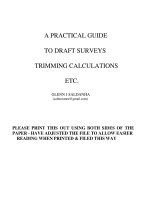Nonsexist research methods a practical guide margrit eichler, routledge, 1991 scan
Bạn đang xem bản rút gọn của tài liệu. Xem và tải ngay bản đầy đủ của tài liệu tại đây (6.58 MB, 189 trang )
NonsexistResearchMethods
Nonsexist Research
Methods
A Practical Guide
MARGRIT EICHLER
Ontario Institutefor Studiesin Education
ROUTLEDGE
New York London
Publishedin 1988 by Allen and Unwin, Inc.
Reprintedin 1991 by
Routledge
An imprint of Routledge,Chapmanand Hall, Inc.
29 West 35 Street
New York, NY 10001
Publishedin Great Britain by
Routledge
11 New FetterLane
London EC4P4EE
Copyright © 1991 by Routledge,Chapmanand Hall, Inc.
Printedin the United Statesof America
All rights reseIVed.No part of this book may be reprintedor
reproducedor utilized in any form or by any electronic,mechanical
or othermeans,now known or hereafterinvented,including
photocopyingand recording,or in any information storageor
retrieval system,without permissionin writing from the publishers.
Library of CongressCataloging-in-Publication Data
Eichler, Margrit.
Nonsexistresearchmethods.
Bibliography: p.
Includesindex.
1. Social sciences- Research. 2. Sexism. 1. Title.
87-11477
H62.E453 1987
300'.72
ISBN 0-04-497044-7
ISBN 0-415-90605-9(pb)
British Library Catalouging in Publication Data
Eichler, Margrit
Nonsexistresearchmethods:a practicalguide.
1. Sexismin social scienceresearch
1. Title.
300'.72
H62
ISBN 0-04-497044-7
ISBN 0-415-90605-9
Contents
Acknowledgments
1 Sexismin Research
pagevii
1
TheFourPrimary Problems
2 Androcentricity
19
3 Overgeneralization
48
4 GenderInsensitivity
65
5 DoubleStandards
85
TheThreeDerivedProblems
6 SexAppropriateness,
Familism,andSexualDichotomism
106
7 GuidelinesforNonsexistResearch
129
Epilogue
166
Appendix:NonsexistResearchChecklist
170
Index
177
AbouttheAuthor
183
Acknowledgments
This book is the result of severalyearsof studyin the areaof sexism
in scholarship and nonsexist alternatives. It has thus profited
immenselyfrom the variousdebatesandpublicationson this topic.
Many but not all of the authorswho havecontributedto this debate
are cited in the text. I have also profited over the years from
discussionswith students.In particular, however, I am grateful to
PaulaCaplan,Marjorie Cohen,Jill Vickers, MaryleeStephenson,
and
Wendy McKeen for reading and commenting on the entire
manuscript,and to Robert Brym and RhondaLenton for reading
and commentingon portions of the manuscript.The commentsof
the readersalso resultedin severalimportant changesin the final
version. Finally, my greatest debt goes to Linda Williams, who
provided invaluable researchassistanceat various points during
the writing of the book.
I would also like to thank the following peoplefor providing me
with specific references: Paula Caplan, Ursula Franklin, Ester
Greenglass,ThelmaMcCormack,Paul Olson, Ruth Pierson,Monica
Townson,and Paul Wiesenthal.
The guidelinescontainedin the book have gone through many
revisionsand applications.Part of themwere developedwithin the
framework of a federal committee,the CanadianWomen'sStudies
vii
viii Nonse}Cist Research Methods
Advisory Committeeof the Secretaryof State'sWomen'sProgramme.
This committeewas establishedto advise the federal government
on whereto locatefive chairs on women'sstudiesendowedby the
Canadiangovernmentfor the five geographicregions of Canada.
Having receiveda broad ratherthan narrow mandate,the committee
addedthe developmentof a set of guidelinesfor nonsexistresearch
to its agenda.The entire committee,consistingof JuneGow (chair),
Donna Greschner,Gilberte Leblanc, Donna Mergler, Beth Percival,
Charlotte Thibault, Jennifer Stoddart, and myself screenedand
discussedtwo earlier versions of the guidelinescontainedin this
book. In particular, Donna Mergler contributed to the present
shapeoftheguidelines.
Finally, I wish to acknowledgegratefully the excellent copyediting done by Patricia Miller. Lisa Freeman-Miller of Allen &
Unwin wasa dreamcometruein whatyouhopefor in aneditor.
Chapter 1
Sexism in Research
1.1 Introduction
12 Sexismin research
1.3 The sevensexist problems
1.3.1 Androcentricity
1.3.2 OvergeneralizationlOverspecificity
1.3.3 Genderinsensitivity
1.3.4 Double standards
1.3.5 Sex appropriateness
1.3.6 Familism
1.3.7 Sexual dichotomism
1.4 Organizationand history of this book
1.5 Sexismand scientific objectivity
1.6 Solving the problem of sexismin research
1.1 Introduction
Over a centuryago, a schoolmasternamedEdwin A. Abbott wrote
an amusing"Romanceof Many Dimensions,"entitled Flatland,l in
which he describedthe adventuresof the Square,a beingfrom a twodimensionaluniverse (Flatland), who explores a one-dimensional
universe (Lineland) and a three-dimensionaluniverse(Spaceland).
1
2
Nonse}Cist Research Methods
1.1
The Squaredescribesthe inability of the King of Lineland, a onedimensional being, to grasp the essenceof a two-dimensional
universe,and then describeshis own incapacityto believe in the
existenceof a three-dimensionaluniverse. It is only when he is
physically lifted out of his own universeand seesit from above (a
dimensionthat is nonexistentin his own Flatland) that he becomes
capableof intellectually graspingthe existenceof three-dimensional
space.
When the Squarereturnsto his own country, he eagerlytries to
spreadthe Gospelof Three Dimensions,but is predictablyput into
prisonasa dangerouslunatic, wherehe languishesat the endofthe
novel,"absolutelydestituteof converts."
The following is an excerptin which our hero, the Square,tries to
convince the King of Lineland that there are, in fact, two
dimensions.He arguesthat, in addition to Lineland's motions of
Northwardand Southward,which are the only directionsin which
lines can move in Lineland, thereis anothermotion, which he calls
from right to left:
KING;
E}Chibit to me, if you please,this motionfrom left to right.
I: Nay,thatI cannotdo, unlessyoucouldstepoutofyourLinealtogether.
KING: OutofmyLine?
Doyoumeanoutoftheworld?OutofSpace?
Well, yes. Out ofyour Space.For your Spaceis not the true Space.True
Spaceis aPlaneibutyourSpaceis onlyaLine.
KING: Ifyou cannotindicate this motionfromleft to right byyourselfmoving
in it, then I begyou to describeit to me in words.
I: If I cannot tell your right sidefrom your left, I fear that no words of mine
can makemy meaningclear to you. But surelyyou cannotbe ignorant
of so simple a distinction.
KING: I donotin theleastunderstandyou.
(Abbott,1952:62)
I:
Like the King of Lineland, we have been brought up in an
intellectually limited universe.Our dilemma is that all our major
concepts,our way of seeingreality, our willingnessto acceptproof,
havebeenshapedby one dimension- onesex- ratherthanby two.
For as long as we remain within this intellectual universe,we are
incapableof comprehendingits limitations, believing it to be the
only world that exists.In orderto truly understandour universe,we
must create a vantagepoint that allows us to observeit both for
what it is and for what it is not. Not an easy task, as the Square
1.1-12
SBl(ism in Research
3
found out when he tried to explain the existenceof left and right to
a personwho had neverexperiencedthem.
Similarly, noneof us haseverlived in a nonsexistsociety:moving
toward nonsexistscholarshipis comparableto tIying to comprehend
a dimension that we have not materially experienced.We can
describeit in theoreticalterms, but we cannotfully appreciateits
natureuntil we areable to lift ourselvesout of our currentconfining
parameters.This involves becoming aware of sexism in research
and starting to eliminate it.
Sexism in researchwas first recognized as a major problem
around the mid-1970s.While books and articles that pointed out
the problemexistedbeforethat time,z it is only sincethe mid-1970s
that critiques have appearedwith some regularity and in more
mainstreamoutlets.
In the early 1970s and continuing into the 1980s, various
organizations,publishers,and publication outlets beganadopting
rules about the use of nonsexist language,3and recently, about
nonsexistcontent.4Nevertheless,sexism in researchis still badly
understood.Evenlesswell understoodis how to conductresearch
in a nonsexistmanner.
This book has two major objectives:(1) to presentan analysisof
sexismin researchthat enlargesour understandingof this problem
and sensitizesstudentsand researchersto sexism in its various
manifestations;and(2) to provideguidelinesfor solving the problem
that offer clear and concisemeansof creatingnonsexistalternatives.
1.2 Sexism in Research
Most analysesof sexism in researchfocus either on one discipline
or subjectareaor else on one type of sexism.s Indeed,we do not
tend to speak of "types of sexism," but of "sexism," pure and
simple.s The term "sexism" suggeststhat we are dealing with one
problem that may manifest itself in different areasdifferently, but
which neverthelessis a single basicproblem- what one might call
the "big blob" theory of sexism.
This book takesa different approach.Sexismis herebrokendown
into sevendifferent types. Of these seventypes, four are primary
4
Nonse;cistResearchMethods
1.2
and three are derived. Primary problemsare thosethat cannotbe
reducedone to the other, althoughthey coexist and often overlap.
Derived problemsare problemsthat are not logically distinct from
the primary problems but which appearso frequently that they
warrant being identified by a special label. The primary problems
are: (1) androcentricity, (2) overgeneralization,(3) gender insensitivity,
and (4) doublestandards.Derived problemsare: (5) sex-appropriateness, (6) familism, and (7) sex-ual dichotomism.There is a certain
arbitrarinessabout identifying seven,ratherthan, say, six or five or
eight sexistproblemsin research?Thereis also a certainrubitrariness
in the mannerin which the boundarieshavebeendrawn.The seven
problemspresentedhere have emergedthrough many attemptsto
order the otherwise diverse materials concerning critiques of
sexism. The successof the approach presentedhere does not
dependon acceptanceof this categorizationas the bestpossibleor
on correctlypigeonholingempirical problemsundertheir appropriate
theoreticallabels, however.Instead,what is important is recognizing
that sexism is multidimensional rather than unidimensional,
identifying a sexist problem as such, and rectifying it. In other
words,the sevenproblemsareintendedto serveas tools to facilitate
the recognitionand correctionof sexismin research,ratherthan as
an ultimate systemof categorization.
It is helpful to think of the four primary problems as a set of
movablecircles. They all have a different core, and sometimesthey
overlap very heavily, sometimesonly at the periphery, sometimes
not at all. Occasionally,all four circles may overlap.Thus theremay
be more than one correct classification of a problem. The three
derived problems, in contrast, can be thought of as constituting
inner rings that are strongly defined within two of those larger
circles.
The following preliminary definitions of all sevenproblemswill
be expandedin Chapters2-6, where more extensiveillustrations
are provided: Chapter7, organizedby componentsof the research
process,offers a set of guidelines for detecting and eliminating
sexismin research.
1.3
Sexism in Research
5
1.3 The SevenSe}(ist Problems
1.3.1 Androcentricity
Androcentricity is essentially a view of the world from a male
perspective.It manifests itself when ego is constructedas male
ratherthanfemale, suchas when "intergroupwarfare" is definedas
a "meansof gaining women and slaves."In this case,the "group" is
defined as consistingonly of males, since the women are what is
"gained." From an androcentricperspective,women are seen as
passiveobjectsratherthan subjectsin history, as actedupon rather
than actors; androcentricitypreventsus from understandingthat
both males and females are always acted upon as well as acting,
although often in very different ways. Two extreme forms of
androcentricity are gynopia (female invisibility) and misogyny
(hatredof women).
This definition raises a difficulty that must be acknowledged.
Theoreticallyspeaking,problemsof perspectivecould comein two
versions: one female, one male. The female version would be
gynocentricity,or a view of the world from a female perspective.I
havelabeledthis problemandrocentricityratherthan, for instance,
andro-gynocentricityfor two reasons. First, the problem is so
overwhelminglybiasedin the male direction that to accorda female
versionof the problemequalstatuswould be inappropriate.I have,
however,includedthe few examplesof incipient gynocentricitythat
I found in my search of the literature. Second, it is not really
possible to find a form of gynocentricity that is in any way
comparableto androcentricity,for the simple reasonthat we live in
an androcentricsocial,political, andintellectualenvironment.Thus
evenwhenwe attemptto take a consciouslyfemaleperspective,this
attemptoccurswithin an overall intellectualenvironmentin which
both our vehicle for thought (language)and the contentof thought
(concepts) are colored by thousandsof years of overwhelmingly
androcentricthinking. It is thereforeboth misleadingand inaccurate
to treat possiblegynocentricityas comparableto actual androcentricity. However, it is important to acknowledgethat sexism can
theoretically come in two forms, and to remind ourselves that
neitheris acceptablein scholarship.
6
Nonse}Cist Research Methods
1.3
1.3.2 OvergeneralizationlOverspecijicity
Overgeneralizationoccurswhena studydealswith only onesexbut
presentsitself as if it were applicableto both sexes.Its flip side is
overspecificity, which occurs when a study is reportedin such a
mannerthat it is impossibleto determinewhetheror not it applies
to oneor both sexes.Using a sampleof maleworkersandcalling it a
study of social class is an instanceof overgeneralization;sex.same
problem arises when one uses the term "parents" tb refer
exclusively to mothers (ignoring fathers). Overspecificity occurs
when single-sexterms are usedwhen membersof both sexesare
involved (e.g., "the doctor ... he, or "man is a mammal").Many (but
not all) of the problems involving sexist languagebelong in this
category.
There is considerableoverlap betweenovergeneralizatiOnloverspecificity and androcentricity.Nevertheless,one cannot be equated
to the other. A study may be androcentricwithout being overgeneral,suchaswhenmaleviolenceagainstwomenis dismissedas
trivial or unimportant(thus maintainingmale overfemale interests)
although the actors are correctly identified by their sex. A study
may also be overgeneralor overspecificwithout being necessarily
androcentric,such as when a study uses all male subjects (e.g.,
male students)or all femalesubjects(e.g.,mothers)but presentsthe
findings in general terms ("students" respond well to ability
grouping, or "parents" tend to teach their children concepts
throughostensivedefinitions).
1.3.3 GenderInsensitivity
Genderinsensitivity is a simple problem:it consistsof ignoring sex
as a socially important variable. It sometimes overlaps with
overgeneralizationloverspecificity,
but the two are not identical: In
the caseof generalinsensitivity, sexis ignoredto sucha degreethat
the presenceof overgeneralizationor androcentricitycannoteven
be identified. If a study simply fails to report the sex of its
respondents,or if a policy study completelyignores the different
effects of, let us say, a particular unemploymentinsurancepolicy
on the two sexes,then we cannotidentify whethermale or female
subjects were included or whether males or females would
1.3
Se}Cismin Research
7
differentially profit from or be hurt by a particular policy. In a
completely gender-insensitivestudy, it would be impossible to
identifY other problemsbecauseinformation necessaryto do so is
missing.
1.3.4 Double Standards
The use of double standardsinvolves evaluating, treating, or
measuring identical behaviors, traits, or situations by different
means.A doublestandardis by no meanseasyto identity, although
it may sound easy: it involves recognizing behaviors, traits, or
situations as identical when they bear different labels or are
described in different terms. For instance, some psychological
disordersoccuronly in one sex. To find out whetheror not a given
exampleis an instanceof the applicationof a doublestandard,one
must (1) identifY a larger categoryfor the disorder; (2) determine
whether there is a complementarydisorder for the other sex;
(3) identifY whether the two are equivalent; and (4) determine
whetherthey are evaluatedin different ways. Only when all these
preconditionsobtain are we dealingwith a double standard.If the
disorderappearsin only one sex, no double standardis involved.
Identification is not madeeasierby the fact that a researchermay
have used different instrumentsto measureidentical attributesof
the sexes.For example,social statusis currently derived by using
different measuresfor the sexes (for further discussion of this
specific problem,seeChapterS).However,this different measurement
coincideswith an actual differencein social standingbetweenthe
sexes,a difference that we are incapableof measuringadequately
becausewe haveno sex-freeinstrumentat our disposal.Identification
of a double standard thus involves distancing oneself to some
degreefrom the social contextasit is presented- not a simplething
to do, and neverperlectly achieved.
A double standard is likely to be inspired by, or lead to,
androcentricity,but it need not necessarilydo so. Using femalederived categoriesof social status for women and male-derived
categoriesfor men is an instanceof a doublestandardin the use of
instruments,but it is neither genderinsensitivenor androcentric
nor overgeneralloverspecific.
8
Nonse}(ist Research Methods
1.3
1.3.5 Sell Appropriateness
Sex appropriateness,
our first "derived" category,is nothing but a
particular instanceof a double standard,one that is so accepted
within the relevantliterature that it is proudly acknowledgedwith
specialterms: for example,"appropriatesex roles," or "appropriate
gender identity." The absenceof appropriategender identity is
called dysphoria, and it is classedas a psychologicaldisorder.Sex
appropriateness
becomesa problemwhen humantraits or attributes
are assignedonly to one sex or the other and are treatedas more
importantfor the sex to which they have beenassigned.It is not a
problem when we are dealing with a truly sex-specific attribute,
suchas the capacityto ejaculateor to give birth to children. It is a
problem when it is applied to such human capacitiesas child
rearing (as opposedto child bearing).
This particular exampleof a double standardhas been singled
out from the overall discussionof double standardsbecausesex
appropriateness
is still widely acceptedwithin the social science
literature as a legitimate concept.
1.3.6 Familism
Familism is a particularinstanceof genderinsensitivity. It consists
of treatingthe family as the smallestunit of analysisin instancesin
which it is, in fact, individuals within families (or households)who
engagein certainactions,have certainexperiences,and so on. It is
not a problemof sexismwhen no suchattribution occurs.Another
manifestationof familism occurswhen the family is assumedto be
uniformly affected (positively or negatively) in instancesin which
the same event may have different effects on various family
members.
This problemhasbeensingledout from the generaldiscussionof
genderinsensitivity for the same reasonthat sex appropriateness
hasbeensingledout from the discussionof doublestandards:It is a
very well-acceptedpracticewithin the social sciencesto engagein
familism, andis, at present,still consideredto be entirelylegitimate.
1.3-1.4
Se;cismin Research
9
1.3.7 SexualDichotomism
Sexual dichotomism is another subaspectof the use of double
standards.It involves the treatmentof the sexes as two entirely
discrete social, as well as biological, groups, rather than as two
groupswith overlappingcharacteristics.It leadsto an exaggeration
of sexdifferencesof all typesat the expenseof recognizingboth the
differencesand the similarities betweenthe sexes.It is particularly
important to recognize sexual dichotomism as a form of sexism
becauseit is sometimesused as a "cure" for genderinsensitivity.
When this occurs, it is simply a case of substitutingone form of
sexism for another;and it is doubly misleadingbecauseit creates
the illusion of having achieveda solution.
1.4 Organization and History of this Book
This book is organized around two major axes: type of sexist
problem, and component of the research process in which
particular types of problems may appear.Chapters2 through 5
eachdealwith one primary problem,Chapter6 dealswith the three
derived problems,and Chapter7 and the checklist (seeAppendix)
are organized around the various componentsof the research
process.This structureevolved after a period of trial and error in
which I tried to organizethe book only aroundthe type of problem,
or only around the researchcomponents.Being dissatisfiedwith
both, I eventuallysettledon a compromisestructurethat combines
both organizingprinciples.
The problem-orientedchaptersinclude examplesdrawn from
actual research.The majority are taken from recent issues of
journals, mostly from 1985. Occasionally, other publications are
used (books, reports of committees),and occasionallyI also draw
on other researchers'critiques of sexism. However, the easewith
which examplescan be drawn from academicjournalsdemonstrates
the peIvasivenessof sexism: It exists in every social science
discipline8 and in virtually any nonfeministpublication, no matter
how respectableor how current. Moreover, the problems are
similarregardlessof diSciplineorpublicationoutlet.9
10
Nonse}Cist Research Methods
1.4
My method was simple: I went into a library and picked up
whatever recent issue of journals from different disciplines was
lying on top in the journal pigeon holes. I assumedthat it would
make little difference which journal or issue I picked, and that I
would find at least one example of sexism in every single one.1°
Sadly, this turned out to be correct.
This method of finding many of my examplesalso points to a
major limitation in this book that must be made clear: There is a
large element of chance involved in who and what gets cited.
Dependingon which journal issue I picked up first, the example
may have been taken from psychologywhen I could just as well
have taken it from anthropologyor sociology.The sameappliesto
authors. The examples presentedhere are, therefore, just that:
examples,no more, no less.They are not indicative of the degreeor
type of sexismprevalentin any pruticularauthor,field of investigation,
or discipline.
It is possible, indeed likely, that particular problems are more
prevalentin certain disciplines or subjectareasthan in others (or
indeed, that a particular problem does not occur in some
disciplines).However, to demonstratethis is not a task undertaken
in this book. It is clearly a secondstep. Nor is there any intent to
pronounceon the relative frequencyor importanceof eachof the
problems.That, too, is clearly a secondstep.The intention here is
simply to demonstratethe existenceof distinct typesof sexismthat
occurin the social sciences,to offer meansfor their identification,
andto providesuggestions
for theirsolution.
Chapter7 presentsa systematicdiscussionof potential sexist
problemsfollowing the various componentsof the researchprocess.
Becausethe analysisis meantto be generallyapplicableto various
disciplines and methodologicalapproaches,not all components
are applicableto all studies.For instance,manystudiesdo not have
a policy component.Other studiesdo not ask direct questionsof
respondents.
All studies,on the other hand,presumablyuse major
concepts,have a title, and ask a researchquestion, even if only
implicitly. In addition, please note that although the guidelines
havegone througha processof considerabletestingand revision, I
make no claim that all the problems of sexism in researchare
included in them. We are constantly becoming aware of new
problems.
The guidelinesset forth in Chapter7 are meant to assistin the
1.4-1.5
Se}Cismin Research 11
identification and eventualresolution of sexist problems.They do
not, of course, solve other researchproblems: a study may be
entirely nonsexist and still be trivial or otheIWise bad research.
However, a study cannot be sexist and constitute good research.
The guidelines therefore spell out a set of necessarybut not
sufficient criteria for good research.
1.5 Se}(ismand Scientific Objectivity
One spinoff from the various critiques of sexism in researchhas
been a reneweddoubt about the possibility of objectivity in the
social sciences.While academicianshave traditionally assumed
that objectivity is a hallmark of their work, feminist scholarshave
challenged this assumption. Some feminist researcherseven
maintainthat objectivity is, in principle, impossibleto achieve,and
that the most we can do is to admit to an unabashedsubjectivity,
our own as well as everybody else's.11 However, the logical
consequence
of sucha principledstanceis that research,including
the implied cumulativeknowledgeit generates,is impossible.
This seemsratherlike throwing out the babywith the bathwater.
Instead, it is more useful to identify the various components
commonly included under the headingof objectivity and look at
them separately,in order to eliminate the problematic aspectsof
objectivity while maintaining the useful ones. One scholar who
engagesin such a process of separating useful from harmful
componentsof objectivity is ElizabethFeeY' She suggeststhat the
following "aspectsof scientific objectivity ... should be preserved
and defended":
The conceptof creating knowledge through a constantprocessof
practical interaction with nature, the willingness to consider all
assumptionsand methodsas open to questionand the expectation
that ideaswill be subjectedto the most unfetteredcritical evaluation.
13
12
Nonse;cistResearchMethods
1.5
Fee also rejects certain aspectsof "objectivity" in research.For
example, she rejects as not helpful the notion that objectivity
requiresa distancingof the researcher
from the subjectmatter,and
of the productionof knowledgefrom its uses.Likewise, she rejects
as unnecessarythe divorce between scientific rationality and
emotional or social commitment;she also rejects the assumption
that knowledge must flow only from the expert to the nonexpert
andthus that a dialogueis not possible.Shedeploresthe prevailing
split betweensubject and object, in which the knowing mind is
activeandthe objectof knowledgeentirely passive.Sucha structure
of knowledgeresultsin a depersonalized
voice of abstractauthority
that legitimizes domination. Finally, she rejects as impossiblethe
completefreedom of researchfrom its sociopolitical environment.
Though she focuses on the concept of the "scientific process"
and not on "objectivity" per se, Karen Messing argues that "the
ideology and the backgroundof the researcher"can influence the
researchprocessat eleven different stages:14
• the selectionof the scientists,
• their accessto facilities for scientific work,
• the choice of researchtopic,
• the wording of the hypothesis,
• the choice of experimentalsubjects,
• the choice of appropriatecontrols,
• the methodof obselVation,
• data analysis,
• interpretationof data,
• the publication of results,
• and the popularizationof results.IS
Jill McCalla Vickers list as one of her methodologicalrebellions
"the rebellion againstobjectivity,"16 which she seesas (a) "treating
those you study as objects and objectifYing their pains in words
which hide the identity of their oppressors/'or (b) "being detached
1.5
Sexism in Research
13
from that which is studied."17She acceptsobjectivity as "the rules
which are designed to facilitate intersubjective transmissibility,
testing, replication, etc."18
Finally, Evelyn Fox Keller has beautifully demonstratedthat
objectivity has been largely equated with masculinity.19 She
discussesparticularly the misconceptionthat objectivity requires
detachment of the knower, both in emotional as well as in
intellectual terms. Moreover, she arguesthat
the disengagement
of our thinking aboutsciencefrom our notionsof
what is masculinecould lead to a freeing of both from someof the
rigidities to which they have beenbound, with profound ramifications
for both. Not only, for example, might science become more
accessibleto women,but, far more importantly, our vel)' conception
of "objective" could be freed from inappropriateconstraints.As we
begin to understandthe ways in which science itself has been
influencedby its unconsciousmythology, we can begin to perceive
the possibilitiesfor a sciencenot bound by such mythology.20
It seems,then, that it is possibleto be critical of the way in which
objectivity hasbeendefinedwithout havingto abandonthe concept
and sink into the morass of complete cultural subjectivism.We
needto separateclearly objectivity from detachmentand from the
myth that researchis value-free.Neitherof the latter two conditions
is, in principle, possiblefor any researcher(or anybodyelse). Our
valueswill always intrude in a numberof ways into the research
process,beginningwith the choiceof the researchquestion;andwe
will necessarilyalwaysbe informedby a particularperspective.Nor
is thereany needto detachourselvesemotionallyfrom the research
process- in fact, this is impossible,and what appearsas scholarly
detachmentis in reality only a matterof careful disguise.
Objectivity remainsa useful and important goal for researchin
thefollowingways:
(1) a commitmentto look at contral)' evidence;
(2)
a determinationto aim at maximumreplicability of any study (which
implies accumtereportingof all processesemployedand separation
betweensimplereportingand interpretation,to the degreethat these
are possible);
14
Nonse;cistResearchMethods
1.5-1.6
(3) a commitmentto "truth-finding" (what KennethBoulding has called
veracity);'!1 and
(4) a clarification and classification of values underlying the research:
nonsexistresearch,for instance,is, basedon the value judgmentthat
the sexesare of equalworth, while androcentricresearchgrows out
of the belief that men are of higher worth (and therefore more
important) than women.
find it useful to think of objectivity as an asymptotically
approachablebut unreachablegoal, with the elimination of sexism
in researchas a station along the way.
1.6 Solving the Problem of SelCismin Research
Whenwe regarda problemas simple, a single solution often seems
appropriate.Once we begin to differentiate among different and
distinct componentsof a problem, however, different and distinct
solutions becomea necessity.When we fail to make the proper
distinctions, we may - unwittingly and despite the very best
intentions- replaceone problem of sexismwith another.
The analysisOf sexismin languageprovidesa casein point. Early
and incisive studiesof sexism in languageconvinceda numberof
organizationsand individuals that sexist languagewas unacceptable
in scholarly research(or elsewhere,for that matter!).22 Typically,
theseanalysespointed out the use of so-calledgenericmale terms
as sexist, and often they included referenceto such demeaning
terms as "girls" for "women," or nonparallelterms (Mrs. JohnSmith
but not Mr. Anne Smith, or the use of Mrs. or Miss, which indicate
marital status,versusMr., which does not).
As a consequence
of thesecritiques, guideswere publishedthat
replaced so-called generic male terms with truly generic terms:
policemanbecamepolice officer; fireman, fire fighter; postman,mail
carrier; workman, worker; chairman, chairperson; mankind,
humanity; and so on. In effect, occupationaland other termswere
"desexed." The generic "he" was replaced with "he or she," or
"s/he," or "they," or "one," or "people," and so on. Guides of this
type continueto be importantand useful, but unlesscare is taken
1.6
Se;cismin Research 15
as to how and when and in what context these gender-neutral
termsare used,anotherform of sexismmay inadvertentlyenterthe
picture.
The use of male (or sex-specific)terms for generic situationsis
one form of overgeneralization,one of our sexist problems.
However, there is anotheraspectto the sameproblem: the use of
genericterms for sex-specificsituations,which is just as problematic
as is the first manifestation.For example,if researcherstalk about
workers in general while only having studied male workers
(constantlyand cautiously using "they/' "people/' "the individual/'
"the person/'and so on, with nary a female in sight), they simply
replaceone sexist problem with anotherin the mannerin which
language is used.23 Language that employs "nonsexist" generic
terms for sex-specific situations creates the same problem in
reverseand constitutesat one and the same time an example of
both overgeneralizationand genderinsensitivity.24In other words,
when the contentis sex specific, the languageusedshouldalso be
sex specific.
Sexismtakesmore than one form, and thereforeways to combat
it may also take more than one form. The trick is to developcriteria
that help us detenninewhich solution is appropriatewhen.This is
the major purposeof this book.
Notes
1 Edwin A. Abbott, Flatland: A Romanceof Many Dimensions INew York: Dover,
1952).
2 See,for instance,Ruth Hershberger,Adam'sRib INew York: Harper& Row, 1970),
first publishedin 1948; or the special issue on sexism in family studiesof the
Journal ofMarriage and the Family 33: 3, 4 11971).
3 An early exampleare the guidelinesby Scott, Foresmanand Co., "Guidelinesfor
improving the image of women in textbooks" 1Glenview, IL, 19721; see also
"Guidelines for equal treatment of the sexes in McGraw·Hill Book Company
publications" In.d.J; "Guidelinesfor nonsexistuse of language,"preparedby the
American Psychological Association Task Force on Issues of Sexual Bias in
GraduateEducation,AmericanPsychologistIJune 1975): 682-684;"Guidelinesfor
nonsexistuse of languagein National Council of Teachersof English pUblications"
IMarch 1976).
4 For example,the CanadianPsychologicalAssociationapproveda set of nonsexist
16
Nonsf:lC.ist ResearchMethods
guidelinesin 1983; seeCannieStark-AdamecandMeredith Kimball, "Sciencefree
of sexism:A psychologist'sguide to the conductof nonsexistresearch:Canadian
Psychology 25: 1 (1984): 23-34. The Canadian Sociology and Anthropology
Associationpasseda motion at its generalannualmeetingin 1984 that all official
publications must be nonsexistin languageand content; see Margrit Eichler,
"And the work neverends:Feministcontributions,"CanadianReviewofSociology
and Anthropology 22, 5 (1985): 619-644, esp. p.633; "AERA guidelines for
eliminating race and sex bias in educationalresearchand evaluation,"Educational
Researcher14, 6 (1985).The AmericanSociologicalAssociationpublisheda set of
guidelinesin one of its publications;see "Sexist biasesin sociological research:
Problemsand issues,"ASA Footnotes(January1980): 8-9, but its major journal,
the AmericanSociologicalReview,does not require that articles be nonsexistin
languageand content.The Social Sciencesand HumanitiesResearchCouncil in
Canadapublisheda booklet suggestingthat sexist researchis bad research;see
Margrit Eichler andJeanneLapointe,"On the treatmentof the sexesin research"
(Ottawa:Social Sciencesand HumanitiesResearchCouncil of Canada,Minister of
Supply and Services,1985/; however, the assessment
forms for projects do not
include a criterion that the researchbe nonsexist.For an overview of strategies
adoptedby Canadianprofessionalsocial scienceorganizationsand scholarly
journals, see Linda Christiansen-Ruffmanet al., "Sex bias in research:Current
awarenessand strategies to eliminate bias within Canadian social science"
(Report of the Task Force on the Elimination of Sexist Bias in Researchto the
SocialScienceFederationof Canada,1986).
5 See,for instance,Shulamit Reinharz,Marti Bombyk, and JanetWright, "Methodological issues in feminist research:A bibliography of literature in women's
studies, sociology and psychology:Women'sStudies International Forum 6, 4
RhondaLenton,Somer
(1983): 437-454;and Margrit Eichlerwith the assistance of
Brodribb, JaneHaddad,and Becki Ross, "A selectedannotatedbibliography on
sexismin research"(Ottawa:Social Sciencesand HumanitiesResearchCouncil of
Canada,19851.
6 This is not alwaystrue. Sexismis occasionallybrokendown into different ways in
which it manifestsitself, but suchdifferent manifestationsare usuallynot seenas
logically distinct. As an example, see Kathryn B. Ward and Linda Grant, "The
feminist critique and a decade of published researchin sociology journals,"
SociologicalQuarterly 26,2 (1985): 139-157.
7 Indeed, my first attempt to identilY a set of superordinatesexist problems
involved six, rather than seven problems; see Margrit Eichler, "Les six plkhes
capitaux sexistes," in Huguette Dagenais (edJ Approches et methodesde la
recherchefeministe. Actes du colloque organise par Ie Groupe de recherche
multidiscipIinairefeministe,Mai 1985.(UniversiteLaval:Maquettiste,1968/:17-29.
8 I do not meanto imply that the problemdoesnot exist in the naturalsciencesas
well. Indeed, we know that it does, as recent analyses have eloquently
demonstrated;see, for example,Ruth Hubbard, Mary Sue Henifin, and Barbara
Fried (edsJ,WomenLook at Biology Looking at Women:A Collection of Feminist
Critiques (Cambridge,MA: Schenkman,1979/; Ruth Bleier, Scienceand Gender:A
Critique ofBiology and Its Theorieson Women(New York: PergamonPress,1984/;
Marian Lowe and Ruth Hubbard (edsJ, Womans Nature: Rationalizations of
Inequality (New York: Pergamon,1983/; SandraHarding and Merrill B. Hintikka
Se;c.ismin Research
17
(eds.), Discovering Reality: Feminist Perspectiveson Epistemology,Metaphysics,
Methodology,and Philosophyof Science(Dordrecht: D. Reidel, 1983). This book
restrictsitself to the social sciencesfor the simplereasonthat I am not competent
to write about the natural sciences.
9 Feminist writings may be sexist as well. However, since the likelihood is much
smallerthan with nonfeministwritings, my searchwould have beenmuch more
arduous, and it simply is not the major problem, I did not include feminist
journals in my search.
10 However,it shouldbe notedthat I did apply a criterion in selectingjournalsfrom
within the samediscipline: In caseswhere there were severaljournals from the
samediscipline, I favored the oneswith the longestrun, as indicatedby volume
number(the higher the number,the longer the run) on the assumptionthat the
olderthe journal, the moreestablishedit could be assumedto be. In addition,the
selectionis heavily biasedtoward U.S. and Canadianjournals.
11 This is, for instance,the position taken by Liz Stanleyand Sue Wise in Breaking
Out: FeministConsciousness
and FeministResearch(London: Routledge&- Kegan
Paul, 1983J.They argue
We don't believe that "science" exists in the way that many people still
claim it does.We don't see it as the single-mindedobjective pursuit of
truth. "Truth" is a social construct,in the sameway that "objectivity" is;
and both are constructedout of experienceswhich are, for all practical
pUlposes,the sameas "lies" and '·subjectivity." And so we sell all research
as "fiction" in the sensethat it views and so constructs"reality" through
the eyes of one person.(p.174)
12 Elizabeth Fee, 'Women'snature and scientific objectivity," in Marian Lowe and
Ruth Hubbard (eds.), Women'sNature: Rationalizationsof Inequality (New York:
Pergamon,1983): 9-27.
13 Ibid., p. 16.
14 Karen Messing,"The scientific mystique:Can a white lab coatguaranteepurity in
the searchfor knowledgeaboutthe natureof women?"in Marian Lowe and Ruth
Hubbard (eds.), Womens Nature: Rationalizations of Inequality (New York:
Pergamon,1983):75-88.
15 Ibid., p. 76.
16 Jill McCalla Vickers, "Memoirs of an ontolOgical exile: The methodological
rebellions of feminist research," in Angela Miles and Geraldine Finn (eds.l,
Feminism in Canada: From Pressure to Politics (Montreal: Black Rose, 1982):
27--46.
17 Ibid., p.40.
18 Ibid. In a more recentarticle, Vickers pushestoward a new epistemology;seeJill
Vickers, "So then what? Issues in feminist epistemology." Unpublished paper
presented at the 4th annual meeting of the Canadian Women's Studies
Association,Winnipeg.1986.
19 Evelyn Fox Keller, Reflectionson GenderandScience(New Haven:Yale University
Press,1985J.
20 Ibid., pp.92-93.
21 KennethE. Boulding, "Learning by simplifying complexity: How to tum datainto
18
Nonse}CistResearchMethods
knowledge; in The Science and Praxis of Comple}City, contributions to the
symposiumheld at Montpellier, France,1984 (Tokyo: United Nations University,
1985): 31. I would like to thank Ursula Franklin for drawing my attentionto this
quote.
22 Some of the early studiesinclude Virginia Kidd, "A study of images produced
through the use of a male pronounas the generic;Movements:Contemporary
Rhetoricand Communication(Fall 1971): 25-30;JosephW. SchneiderandSally L.
Hacker, "Sex role imagery and the use of generic man in introductory texts;
AmericanSociologist8 (1973): 12-18; someof the later studiesinclude Jeannette
Silveira, "Genericmasculinewords and thinking: Women'sStudiesInternational
Quarterly 3,213 (1980): 165-178;JaniceMoulton, GeorgeM. Robinson,and Cherin
Elias, "Sex bias in language use: "Neutral" pronouns that aren't; American
Psychologist 33, 11 (1978): 1032-1036; Mary Vetterling-Braggin (ed'), Sexist
Language:A Modem PhilosophicalAnalysis (Totowa, NJ: Littlefield, Adams,1981);
JohnBriere and Cheryl Lanktree,"Sex-rolerelatedeffectsof sex bias in language;
SexRoles9,5(1983):625-632.
23 Thereis oneexceptionto this generalrule. Whena communicationis intendedto
solicit the representationof both sexes,even thoughonly one is representedat a
given point in time, it may be appropriateto use nonsexist language,as in
announcementsadvertising jobs so far held only by men (for example, fire
fighters, police officers, or chairpersons).
24 Anotherinstancein which an attemptto avoid sexismmay inadvertentlylead to
another type of sexism occurs when researcherstrying to avoid gender
insensitivity fall into the error of sexual dichotomism by treating sex as a
categoricalvariable for all sorts of social phenomena.









